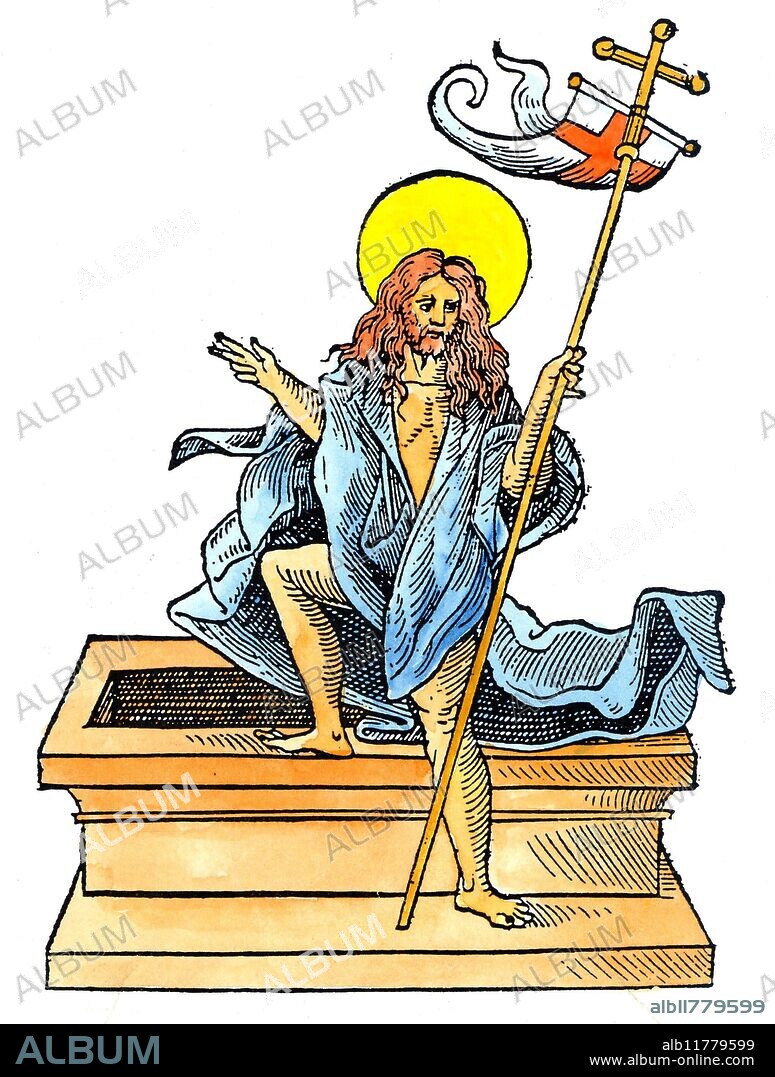alb11779599
ALCHEMY - ROSARIUM PHILOSOPHORUM - RESURRECTION. A much printed alchemical series, the Rosarium Philosophorum consists of a complex text around 20 highly distinctive woodcut prints. The imagery is alchemical, but well disguised behind the hieros gamos, or sacred marriage, sexuality and various Christian symbols.They each relate to the alchemical stages, viewed from a Christian standpoint - perhaps written in the late 15th century by one of the early Rosicrucian schools. Although the text and related images appeared in mediaeval manuscripts, it was not printed until 1550, in a German edition, as part of the De alchimia opuscula, by which time it consisted of 20 woodcuts. The authorship has always remained uncertain, though it has been suggested that it was compiled by Arnold of Villanova, in the 13th century. Jung has argued, from iconographic points relating to the four distinctly religious images, that, in its present form at least, the illustrations do not go back beyond the 15th century. The book was reprinted, with different cuts, many times: a great deal of the meaning of text and images may be gleaned from the later version of the images, and a truncated text, published as part of Johann. Daniel Mylius, Philosophia Reformata, 1622 (the 22 engravings based on the cuts begins at the 29 engraving in the series, though the old numbering is adopted- that is to say, after the 28 engravings the Rosarium series are numbered in sequence from 1 to 22). Final plate. This symolizes the Resurrection of the King, of the Christ, in the initiated alchemist. The water has gone from the sarcophagus, and the duality of male and female, even though formerly expressed as hermaphrodite (for that is the human condition) has been superseded. Thanks to the alchemical process, the human is now integrated and whole. It is right that he be called the Philosopher's Stone, or the Risen King.

|
Add to another lightbox |
|
Add to another lightbox |



Buy this image.
Select the use:

Caption:
ALCHEMY - ROSARIUM PHILOSOPHORUM - RESURRECTION. A much printed alchemical series, the Rosarium Philosophorum consists of a complex text around 20 highly distinctive woodcut prints. The imagery is alchemical, but well disguised behind the hieros gamos, or sacred marriage, sexuality and various Christian symbols.They each relate to the alchemical stages, viewed from a Christian standpoint - perhaps written in the late 15th century by one of the early Rosicrucian schools. Although the text and related images appeared in mediaeval manuscripts, it was not printed until 1550, in a German edition, as part of the De alchimia opuscula, by which time it consisted of 20 woodcuts. The authorship has always remained uncertain, though it has been suggested that it was compiled by Arnold of Villanova, in the 13th century. Jung has argued, from iconographic points relating to the four distinctly religious images, that, in its present form at least, the illustrations do not go back beyond the 15th century. The book was reprinted, with different cuts, many times: a great deal of the meaning of text and images may be gleaned from the later version of the images, and a truncated text, published as part of Johann. Daniel Mylius, Philosophia Reformata, 1622 (the 22 engravings based on the cuts begins at the 29 engraving in the series, though the old numbering is adopted- that is to say, after the 28 engravings the Rosarium series are numbered in sequence from 1 to 22). Final plate. This symolizes the Resurrection of the King, of the Christ, in the initiated alchemist. The water has gone from the sarcophagus, and the duality of male and female, even though formerly expressed as hermaphrodite (for that is the human condition) has been superseded. Thanks to the alchemical process, the human is now integrated and whole. It is right that he be called the Philosopher's Stone, or the Risen King.
Credit:
Album / Charles Walker / TopFoto
Releases:
Image size:
2042 x 2699 px | 15.8 MB
Print size:
17.3 x 22.9 cm | 6.8 x 9.0 in (300 dpi)
Keywords:
 Pinterest
Pinterest Twitter
Twitter Facebook
Facebook Copy link
Copy link Email
Email
